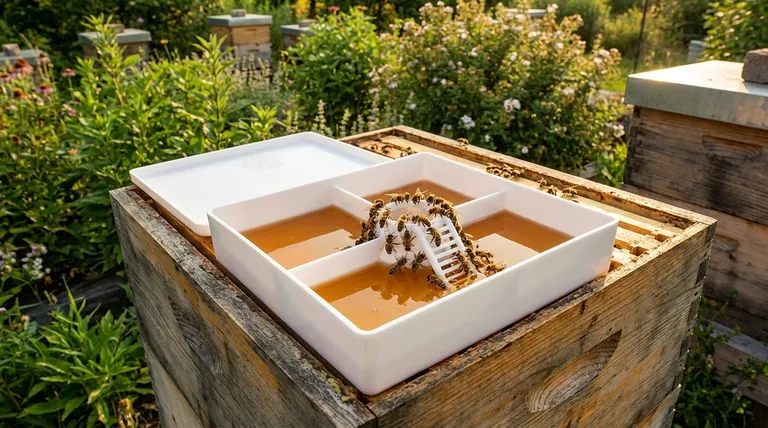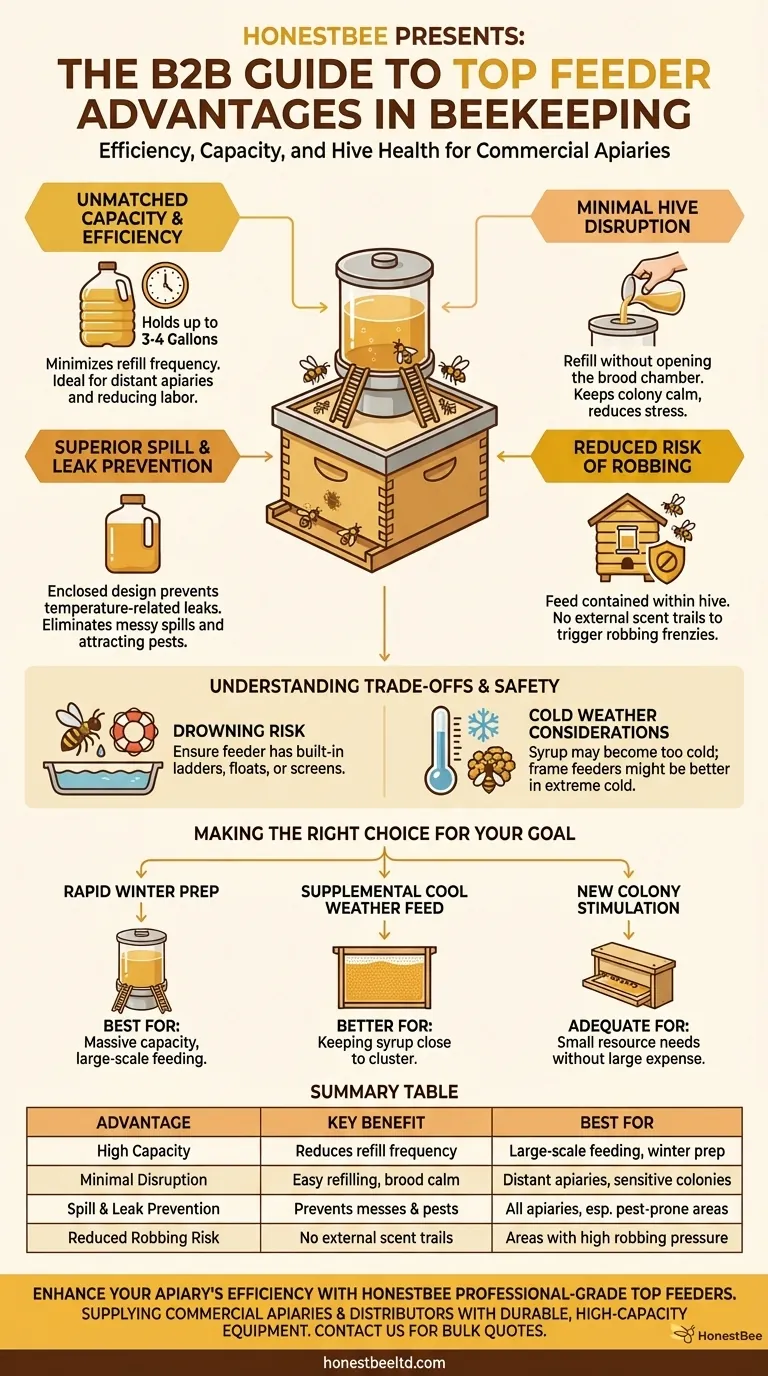When it comes to feeding your bees, top feeders offer significant advantages in efficiency, capacity, and hive health. They are designed to deliver large quantities of syrup quickly and with minimal disturbance to the colony, making them a preferred choice for many beekeepers, especially when preparing hives for winter.
The core decision is not about which feeder is universally "best," but which tool best serves your specific goal. Top feeders excel at delivering large volumes of feed with maximum efficiency and minimal colony stress, but understanding their context is key to using them effectively.

The Core Advantages of Top Feeders
Top feeders are placed directly on top of the uppermost hive box, just under the main hive lid. This position is the source of their primary benefits.
Unmatched Capacity and Efficiency
Top feeders are built to hold a large volume of syrup, often up to three or four gallons depending on the model. This large capacity reduces the frequency of refills.
This makes them ideal for beekeepers managing distant apiaries or for anyone who wants to minimize the labor of frequent feeding. The wide, open design also makes them the fastest and easiest type of feeder to fill.
Minimal Hive Disruption
Refilling a top feeder is one of the least invasive ways to feed a colony. You simply remove the outer and inner covers, pour in the syrup, and close the hive back up.
This process avoids disturbing the brood nest entirely. The bees remain calm, and the colony's internal temperature and structure are left intact, which reduces overall stress.
Superior Spill and Leak Prevention
Unlike jar-style gravity feeders, top feeders are not prone to leaking due to temperature fluctuations that can break a vacuum seal. Their enclosed, one-piece construction contains the syrup securely within the hive.
This design drastically reduces the chance of messy spills down the outside of the hive, which can attract pests and encourage robbing.
Reduced Risk of Robbing
Robbing, where bees from other colonies invade a hive to steal its resources, is a serious threat. Top feeders significantly mitigate this risk.
Because the feed is entirely contained within the hive and accessible only from below, it does not create an external scent trail that attracts robber bees. This is a major advantage over entrance feeders, which can quickly trigger a robbing frenzy.
Understanding the Trade-offs
No single piece of equipment is perfect for every situation. Objectivity requires acknowledging where top feeders have limitations.
Access and Drowning Risk
The design of a top feeder places the syrup in an open trough. While this allows many bees to feed at once, it can pose a drowning risk if not properly equipped.
Most modern top feeders include built-in ladders, floats, or screens that give bees a safe way to access the syrup and climb out. It is critical to ensure your feeder has these safety features.
Top Feeders vs. Frame Feeders
Frame feeders sit inside the hive body, replacing one or two frames. This keeps the feed very close to the brood cluster, which can be an advantage in colder weather when bees are reluctant to travel far.
However, refilling a frame feeder requires you to open the brood box, which is a more disruptive process. Frame feeders also displace frames that could otherwise be used for honey or brood.
Cold Weather Considerations
In very cold temperatures, bees may be unwilling to break their cluster to travel up to a top feeder. The syrup can also get too cold for them to consume.
In these conditions, a frame feeder that keeps the syrup closer to the warmth of the central cluster may be a more effective choice.
Making the Right Choice for Your Goal
Select your feeder based on your primary objective for the colony at that specific time of year.
- If your primary focus is rapid, large-scale feeding for winter preparation: A top feeder is the most efficient tool due to its massive capacity and ease of filling.
- If your primary focus is providing supplemental feed in cool weather: A frame feeder keeps the syrup closer to the bee cluster and may be more effective.
- If your primary focus is stimulating a small, new colony: A smaller feeder, such as an entrance or small frame feeder, may provide all the resources needed without the expense of a large top feeder.
Choosing the right feeder is about matching the equipment's strengths to the colony's immediate needs.
Summary Table:
| Advantage | Key Benefit |
|---|---|
| High Capacity | Holds up to 3-4 gallons, reducing refill frequency |
| Minimal Disruption | Easy refilling without disturbing the brood nest |
| Spill & Leak Prevention | Enclosed design prevents messy spills and pests |
| Reduced Robbing Risk | Feed is contained, eliminating external scent trails |
| Best For | Large-scale feeding, winter prep, and distant apiaries |
Ready to enhance your apiary's efficiency with professional-grade top feeders?
At HONESTBEE, we supply commercial apiaries and beekeeping equipment distributors with high-capacity, durable top feeders designed for minimal disturbance and maximum results. Our wholesale-focused operations ensure you get the reliable equipment you need to support healthy, productive hives.
Contact our team today to discuss your bulk supply needs and get a quote!
Visual Guide

Related Products
- HONESTBEE Professional Hive Top Bee Feeder Feeding Solution
- Professional Hive Top Bee Feeder for Beekeeping
- Classic Boardman Entrance Bee Feeder Hive Front Feeding Solution
- Professional Hive Front Entrance Bee Feeder
- HONESTBEE Round Hive Top Bee Feeder for Syrup
People Also Ask
- What features make top feeders a reliable choice for beekeepers? A Guide to Safe, Efficient Hive Nutrition
- What is a top feeder for bees? Maximize Colony Health with Efficient Feeding
- Do I need an inner cover with a hive top feeder? Optimize Your Hive Setup for Healthy Bees
- What should be done with feeders and equipment after feeding bees? Essential Steps for Apiary Health
- How is the plywood floor fitted into the hive-top feeder? Ensure Longevity with a Floating Floor Design



















